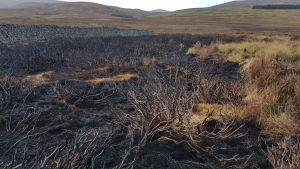Today, 11 September, Moors for the Future Partnership publishes its first annual report. Illustrated with stunning photos of the Peak District and South Pennines, the partnership’s Year in Review is packed with stories that give a flavour of the work completed by the award-winning partnership in the last financial year.
 The look back on the year includes a 13-year tale of perseverance that resulted in a 3 km footpath that gives a breathing space for rare upland birds to breed undisturbed by hikers’ and fell runners’ footsteps; a volunteer view of collecting citizen science data on moorland buds, berries and leaves; and a scientific monitoring campaign carried out by a dedicated team that collected 10,000 individual measurements of water table height on moors across the South Pennines Special Area of Conservation.
The look back on the year includes a 13-year tale of perseverance that resulted in a 3 km footpath that gives a breathing space for rare upland birds to breed undisturbed by hikers’ and fell runners’ footsteps; a volunteer view of collecting citizen science data on moorland buds, berries and leaves; and a scientific monitoring campaign carried out by a dedicated team that collected 10,000 individual measurements of water table height on moors across the South Pennines Special Area of Conservation.
The report contains a full-page map that shows the scale of the partnership’s work, which last year took place across 24 waterbody catchments and stretches from the Roaches in the South of the Peak District National Park to Turley Holes near Todmorden in the South Pennines.
The longstanding Moors for the Future Partnership has been in existence since 2003 and has reversed the fortunes of the upland landscape of the Peak District and South Pennines, which was left scarred by the effects of atmospheric pollution dating back to the industrial revolution. Huge swathes of the highest land in the Peak District and South Pennines were stripped of all plant cover, leaving only bare peat. Without a protective layer, this peat was washing away into streams and rivers, at the rate of 2.5mm per year. Since this time the partnership’s conservation work has tackled the worst of the problem, kick-starting the healing process by covering the bare peat, and reintroducing native plants including Sphagnum moss which is essential to get new peat forming again.
David Chapman, Moors for the Future Partnership Chair and Deputy Chair of the Peak District National Park Authority said:
“This report gives a glimpse into the activities of the past year, when the partnership worked on 29 individual projects, including conservation work over roughly 400 hectares that has protected active blanket bog over a much wider landscape.
“From water companies to NGOs, statutory bodies to land owners and farmers, we have achieved so much for these uplands. This year in review shows the strength of this partnership – though we have different interests in the land, we work together to protect the uplands for the benefit of us all. I hope that this report will give you a flavour of the dedication and pioneering spirit that makes this partnership truly great.”
The report can be downloaded from the Moors for the Future Partnership website.










